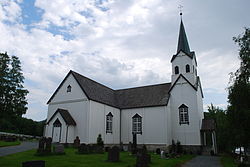Hegra
| Hegra herred | |
|---|---|
| Former Municipality | |

Hegra Church in Nord-Trøndelag
|
|
| Municipality ID | NO-1712 |
| Adm. Center | Hegra |
| Area | |
| • Total | 612 km2 (236 sq mi) |
| Created from | Øvre Stjørdal in 1874 |
| Merged into | Stjørdal in 1962 |
| Hegra | |
|---|---|
| Village | |

View of the village
|
|
| Location in Nord-Trøndelag | |
| Coordinates: 63°27′50″N 11°06′51″E / 63.46389°N 11.11417°ECoordinates: 63°27′50″N 11°06′51″E / 63.46389°N 11.11417°E | |
| Country | Norway |
| Region | Trøndelag |
| County | Nord-Trøndelag |
| District | Stjørdalen |
| Municipality | Stjørdal |
| Area | |
| • Total | 0.42 km2 (0.16 sq mi) |
| Elevation | 20 m (70 ft) |
| Population (2013) | |
| • Total | 505 |
| • Density | 1,202/km2 (3,110/sq mi) |
| Time zone | CET (UTC+01:00) |
| • Summer (DST) | CEST (UTC+02:00) |
| Post Code | 7520 |
Hegra is a village and former municipality in Nord-Trøndelag county, Norway. The former municipality encompassed most of the eastern part of the present-day municipality of Stjørdal. The ancient rock carvings (Leirfald), as well as the small border fort Hegra Fortress (formerly known as Ingstadkleven Fort) are both located in Hegra. The fortress withstood the invading German army from 10 April to 5 May 1940, not surrendering before all other Norwegian units in Southern Norway and Mid-Norway had capitulated.
The 0.42-square-kilometre (100-acre) village of Hegra has a population (2013) of 505. The population density of the village is 1,202 inhabitants per square kilometre (3,110/sq mi). Hegra is located about 10 kilometres (6.2 mi) east of Stjørdalshalsen along the Stjørdalselva river and it is therefore a good site for fishing. Hegra has its own grocery store, gas station, kindergarten, school and a local bank. Hegra is also one of the centers for the resurgence of the Dole Gudbrandsdal horse in Norway. The village is served by the unmanned Hegra Station on the Meråker Line. The European route E14 highway also runs through the village, just south of Hegra Church.
...
Wikipedia


